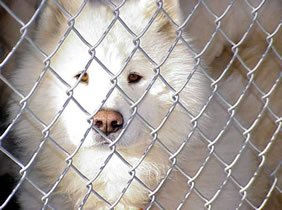Training and Behavior

The number one reason dogs are turned into shelters across the U.S is a lack of training. We can’t tell you the number of times we’ve gotten a dog because the owner has never trained him or her. Of course, that’s not the way the former owner sees the situation – the dog is “stubborn” or “wild” or “won’t listen”, but what it really comes down to is that the human had unrealistic expectations that the dog would somehow magically learn these things on his own as he got older or did not understand how to train a dog and then blamed the dog for his/her shortcomings. Given this, we’d like to share some training information with you, as well as provide some additional resources/reading material for those who would like to learn more. We hope that both you and your dog learn something new and that you both benefit from the information.
AC-CEN-TU-ATE THE POSITIVE
There is a t-shirt that has a cartoon dog on it. The dog’s word bubble says, “Hi! My name is ‘No No Bad Dog’. What’s Yours?” While humorous, it points out an unfortunate truth: Most of us tend to train our dogs by telling them everything they’ve done wrong. However, they will learn more and learn faster if we take the time to tell them when they’ve done something right. As the old saying goes, you catch more flies with honey than with vinegar!!
One thing you should be sure to do is praise your dog when he does something right, and praise him like you really mean it! Mumbling “good dog” in a quiet monotone will not make the same impact as saying the same words with a happy voice and lots of enthusiasm.
Praise is good, but when teaching, it may not be enough. It’s no different than with us – while it is nice if your boss says you did a good job, it’d make more of an impact if s/he gave you a raise to go with it! Be creative about your rewards. The obvious choice is food rewards, but there are other options as well and varying them will help keep training interesting. Make a list of 10 things your dog really loves – treats, a good scratch in just the right spot, a game of fetch, etc. Knowing these ahead of time will help you make a game plan that will succeed!
When you do use food rewards be careful not to give your dog too many treats; keep the pieces small, so a) he doesn’t gain weight and b) you don’t have to break your training rhythm for him to chew. A small piece of a biscuit will mean as much to him as getting a whole biscuit – he won’t differentiate between the two; all he’ll know is he was rewarded. Also consider using baby carrots, pieces of his regular dog food, or tiny pieces of ham, chicken, freeze-dried liver treats, rather than relying on commercial treats which are loaded with fat, sugar and salt.
If you do a lot of training and your dog is starting to gain weight, cut back the amount of food you give him at mealtime. Learning manners should be no excuse for his getting fat!! As your dog gets better/more reliable with any particular exercise, reduce the treats and rely on praise instead. Not only will this keep your dog from gaining weight, but it will also help the behavior become more automatic. Afterall, you don’t want to fall into the trap where your dog will only do something when you have a treat.
BASIC TIPS FOR SUCCESSFUL TRAINING
*Keep it upbeat! If it’s not fun, neither you nor your dog will have a good time nor will you accomplish much.
*Keep the sessions short. You will accomplish more by doing 10-15 minute sessions 2 or 3 times a week than you will if you try 1 one-hour session.
*Set your dog up to succeed. You want to manage the training session so the obvious answer is to “get it right”. We’ve all experienced situations where we’ve been set up to fail & it doesn’t feel very good. It won’t feel any better to your dog, but succeeding will!
*Go at your dog’s pace. If he’s not getting it, he’s not being stubborn or difficult — you are moving too fast! Back up and try repeating the previous steps. Once he’s doing those quickly and easily, try it again.
*Don’t repeat yourself. Saying “sit”, “sit”, “Rover, sit”, “I said ‘sit'” doesn’t help. In fact, it teaches him that he can ignore you the first time around. Once the dog knows what the command means, it should be said one time and one time only. It’s a simple pass/fail – if he does it right, praise/reward, if he doesn’t, he gets nothing.
*Be consistent! It’s confusing to the dog if sometimes it’s ok to do something, but other times he gets in trouble for it. Also, make sure all family members are on-board with the idea – one person who allows the dog to jump up on people or get on the furniture will set back another’s attempt to teach him not to.
*Always end on a positive note!! You want your dog to look forward to the next training session.
by Ellen Engle, MidAtlantic Samoyed Rescue
(Reprinted with permission. No reproductions of this article allowed without author permission.)
